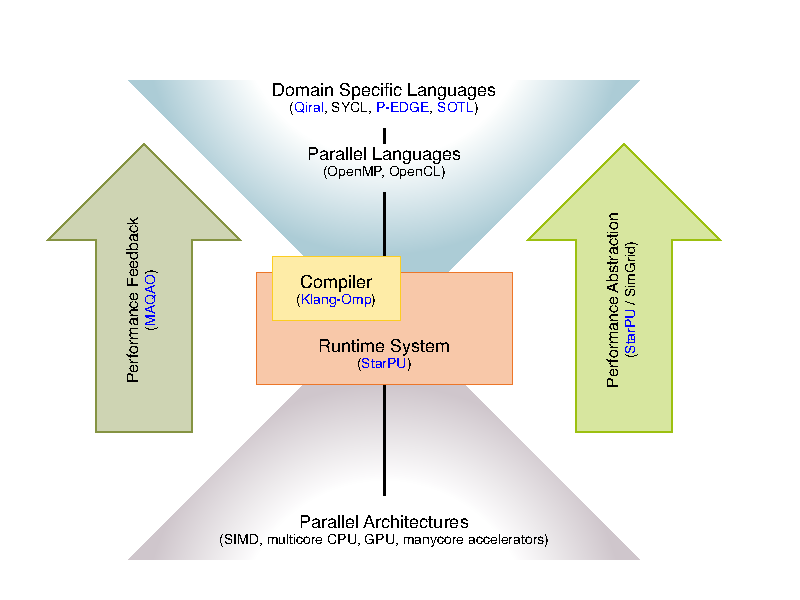Section: Overall Objectives
Overall Objectives
A successful approach to deal with the complexity of modern architectures is centered around the use of runtime systems, to manage tasks dynamically, these runtime systems being either generic or specific to an application. Similarly, on the compiler side, optimizations and analyses are more aggressive in iterative compilation frameworks, fit for library generations, or DSL, in particular for linear algebra methods. To go beyond this state of the art and alleviate the difficulties for programming these machines, we believe it is necessary to provide inputs with richer semantics to runtime and compiler alike, and in particular by combining both approaches.
This general objective is declined into two sub-objectives, the first concerning the expression of parallelism itself, the second the optimization and adaptation of this parallelism by compilers and runtimes.
-
Expressing parallelism: As shown in the following figure, we propose to work on parallelism expression through Domain Specific Languages, able to capture the essence of the algorithms used through usual parallel languages such as OpenCL, OpenMP and through high performance libraries. The DSLs will be driven by applications, with the idea to capture at the algorithmic level the parallelism of the problem and perform dynamic data layout adaptation, parallel and algorithmic optimizations. The principle here is to capture a higher level of semantics, enabling users to express not only parallelism but also different algorithms.
-
Optimizing and adapting parallelism: The goal here is to leverage the necessary adaptation to evolving hardware, by providing mechanisms allowing users to run the same code on different architectures. This implies to adapt parallelism, in particular the granularity of the work, to the architecture. This relies on the use of existing parallel libraries and their composition, and more generally the separation of concern between the description of tasks, that represent semantic units of work, and the tasks to be executed by the different processing units. Splitting or coarsening moldable tasks, generating code for these tasks and scheduling them is part of this work.
Finally, the abstraction we advocate for requires to propose a feed back loop. This feed back has two objectives: To make users better understand their application and how to change the expression of parallelism if necessary, but also to propose an abstracted model for the machine. This allows to develop and formalize the compiling, scheduling techniques on a model, not too far from the real machine. Here, simulation techniques are a way to abstract the complexity of the architecture while preserving essential metrics.



